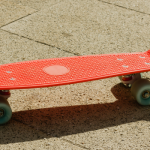Skateboarding is a popular extreme sport enjoyed by people of all ages around the world. However, it’s not uncommon for beginners or even experienced skateboarders to experience pain in their legs while riding. This can be frustrating and discouraging, especially if it interferes with your enjoyment of the sport.
In this article, we will explore some possible reasons behind why your legs might hurt when you skateboard, and offer tips on how to prevent and alleviate this discomfort. So, if you’re ready to hit the pavement pain-free, read on.
Possible Causes of Leg Pain while Skateboarding
There are several potential factors that could contribute to leg pain while skateboarding. Here are some common ones:
Muscle Fatigue and Overexertion:
Explanation: Skateboarding demands intense physical effort, engaging various muscle groups in your legs. If you push yourself too hard without adequate rest, your muscles can become fatigued and overworked. This often leads to soreness and discomfort.
Solution: Take regular breaks during your skate sessions to allow your muscles to recover. Stay hydrated, and listen to your body’s signals for fatigue. Incorporate rest days into your routine to prevent overexertion and promote muscle recovery.
Improper Foot Placement:
Explanation: Incorrect foot positioning on the skateboard can lead to biomechanical issues, causing strain on your legs. Placing your feet too far forward or backward can affect your balance and lead to discomfort.
Solution: Pay attention to your foot placement on the skateboard. Experiment with different stances to find what feels most comfortable for you. Ensure that your feet are evenly spaced, and your weight is distributed evenly to avoid unnecessary stress on specific muscles.
Inadequate Warm-up and Stretching:
Explanation: Failing to warm up before skateboarding can result in tight muscles and decreased flexibility. This lack of preparation may contribute to muscle strain and discomfort during your skate session.
Solution: Prioritize a comprehensive warm-up routine before hitting the skateboard. Include dynamic stretches for your legs, focusing on key muscle groups like quadriceps, hamstrings, and calves. This prepares your muscles for the physical demands of skateboarding.
Impact and Vibration:
Explanation: Skateboarding involves constant impact and vibration as your board rolls over various surfaces. This repetitive stress can lead to muscle soreness, especially in the lower extremities.
Solution: Invest in quality skateboard shoes with sufficient cushioning to absorb impact. Consider using shock-absorbing insoles to reduce the strain on your feet and legs. Additionally, choose smoother surfaces to skate on to minimize the impact and vibration transmitted to your legs.
Muscle Imbalances:
Explanation: Imbalances in muscle strength and flexibility can contribute to leg pain. Certain muscles may become overused while others remain underdeveloped, leading to strain and discomfort.
Solution: Incorporate targeted strength training exercises into your routine to address muscle imbalances. Focus on exercises that strengthen the quadriceps, hamstrings, calves, and hip abductors. A balanced musculature provides better support and reduces the risk of pain and injuries.
Inadequate Protective Gear:
Explanation: Without proper protective gear, your legs are more susceptible to injuries, bruises, and abrasions. The lack of protection can result in heightened discomfort and prolonged recovery.
Solution: Wear appropriate protective gear, including knee pads, shin guards, and ankle braces. These items act as a buffer against impact-related injuries and provide an additional layer of support for your legs. Investing in quality gear is essential for a safer and more enjoyable skateboarding experience.
Is it normal to be sore after skateboarding?
Yes, it is entirely normal to experience soreness after skateboarding, especially if you’re engaging in the sport regularly or pushing your physical limits. Skateboarding involves a combination of balance, coordination, and muscle engagement, and as a result, various muscle groups are used during a skateboarding session.
The soreness you feel is often referred to as delayed onset muscle soreness (DOMS). DOMS typically occurs 24 to 48 hours after intense physical activity and is characterized by stiffness, tenderness, and discomfort in the muscles involved. It is a natural response to the stress placed on the muscles during exercise.
Here are some reasons why you may experience soreness after skateboarding:
- Muscle Engagement: Skateboarding requires the use of leg muscles for pushing, turning, and maintaining balance. Additionally, the upper body is engaged for stability and performing tricks.
- Unfamiliar Movements: If you’re trying new tricks or maneuvers, your muscles may be subjected to unfamiliar movements, leading to soreness.
- Impact and Vibration: The impact of landing tricks, riding on rough surfaces, and absorbing vibrations through the board can contribute to muscle fatigue and soreness.
- Intensity and Duration: Longer or more intense skateboarding sessions can increase the likelihood of muscle soreness.
While soreness is normal, there are ways to alleviate and minimize it:
- Stretching: Incorporate dynamic stretches before skateboarding to warm up your muscles, and static stretches afterward to improve flexibility and reduce muscle tightness.
- Proper Warm-Up and Cool Down: Gradually warm up your body before intense skateboarding sessions, and cool down afterward to promote muscle recovery.
- Hydration and Nutrition: Stay hydrated and ensure you have a balanced diet rich in nutrients to support muscle recovery.
- Rest and Recovery: Allow your body sufficient time to rest between skateboarding sessions. Overtraining can contribute to prolonged soreness and increase the risk of injury.
- Quality Gear: Invest in quality skateboard shoes with good shock absorption to reduce the impact on your legs and joints.
It’s important to distinguish between normal muscle soreness and pain that may indicate an injury. If you experience persistent or severe pain, it’s advisable to consult with a healthcare professional to rule out any serious issues and to receive appropriate guidance on recovery.
Conclusion
Leg pain while skateboarding is a common issue that can often be addressed with proper preparation, technique, and recovery strategies.
By understanding the causes and implementing preventive measures, skateboarders can enjoy their passion while minimizing the risk of leg pain and injuries.
Remember to listen to your body, prioritize safety, and have fun on your skateboard!
![Why do skateboarders hate scooters? [Reasons + Tips] Why do skateboarders hate scooters? [Reasons + Tips]](https://bedoper.site/wp-content/uploads/2023/04/Why-do-skateboarders-hate-scooters-150x150.png)


![How fast do skateboards go downhill? [90 mph (145 km/h)] How fast do skateboards go downhill? [90 mph (145 km/h)]](https://bedoper.site/wp-content/uploads/2023/04/How-fast-do-skateboards-go-downhill-150x150.png)
